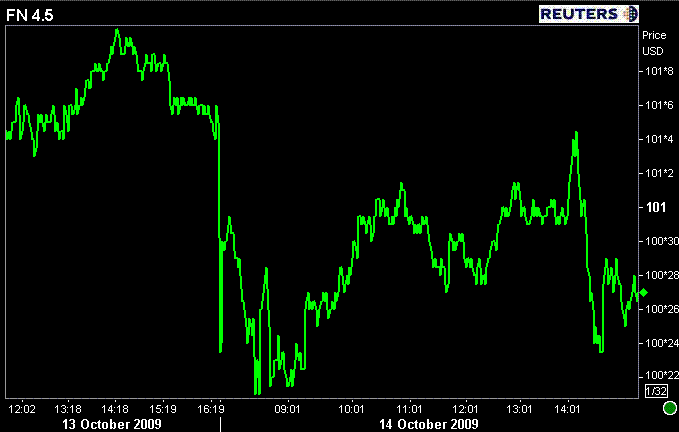Here are some MBS/Real Estate pertinent comments from the FOMC Statement:
The staff briefed the Committee on the current status of the asset purchase programs. Participants noted that the primary influence of the programs is likely through the cumulative effect that they generate on the publicly available stocks of securities. However, they also observed that the rate of new purchases could have an effect on asset prices, especially of MBS.
Given this possibility, participants remarked that a gradual reduction in the pace at which the Federal Reserve buys agency debt and agency MBS could help promote a smooth transition in markets as the announced asset purchases are completed.
Participants observed that such a strategy would be similar to the approach adopted in August for the purchases of Treasury securities and generally viewed it as a useful step to mitigate the risk of a sharp change in yields as purchases end. Participants expressed a range of views about the rate at which asset purchases should be slowed.
Some suggested tapering quickly and completing the purchases by year-end, while a few preferred slowing the rate of purchases over a longer period in order to maintain flexibility regarding the pace and the cumulative amount purchased and thus potentially better calibrate the programs to evolving economic and financial market conditions.
Most participants supported extending purchases of agency debt and agency MBS through through the first quarter of 2010.
In the residential real estate sector, home sales and construction had increased from very low levels, and house prices appeared to be stabilizing. Participants welcomed the cumulating evidence that the housing sector
was beginning to recover, and many participants had marked up their forecasts for housing activity. However, some viewed the improvement as quite tentative, pointing to the pending termination of the temporary tax credit for first-time homebuyers and the winding down of the Federal Reserve’s agency MBS purchase program as potential risks to the outlook for the sector.
Also, some participants questioned whether the recent stabilization in house prices would be sustained as likely further increases in foreclosures would probably put downward pressure on prices. Still, a better outlookfor house prices was an important input to the improved economic outlook; not only would household wealth benefit from a turnaround in such prices, but the exposure of lenders to real estate losses would be diminished.
In contrast to developments in the residential sector, commercial real estate activity continued to fall markedly in most districts, reflecting deteriorating fundamentals, including declining occupancy and rental rates and very tight credit conditions.
With respect to the large-scale asset purchase programs,some members thought that an increase in the maximum amount of the Committee’s purchases of agency MBS could help to reduce economic slack more quickly than in the baseline outlook. Another member believed that the recent improvement in the economic outlook could warrant a reduction in the Committee’s maximum purchases. However, all members were able to support an indication by the Committee of its intention at this time to purchase the full $1.25 trillion of agency MBS that it had previously established as the maximum for this program.
Plain and Simple: FOMC members have mixed outlooks on the residential real estate market and the exit strategy from the Agency MBS Purchase Program. In my intrepretation of the above statement, there is hope for more Fed MBS money if residential real estate experiences another leg down.
Following the release of the FOMC minutes, the 10yr TSY yield rose to 3.42% and rate sheet influential MBS prices moved lower.
The FN 4.0 is -0-13 at 98-09 yielding 4.1775% while the FN 4.5 is trading -0-12 at 100-25 yielding 4.406%. The secondary market current coupon is 4.326%

Some lenders may be preparing for a REPRICE FOR THE WORSE





